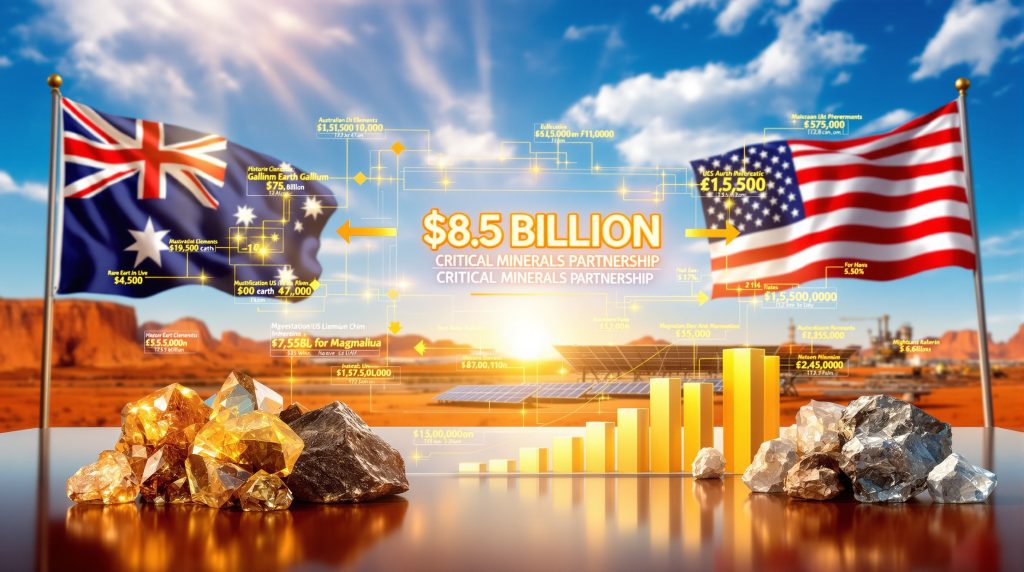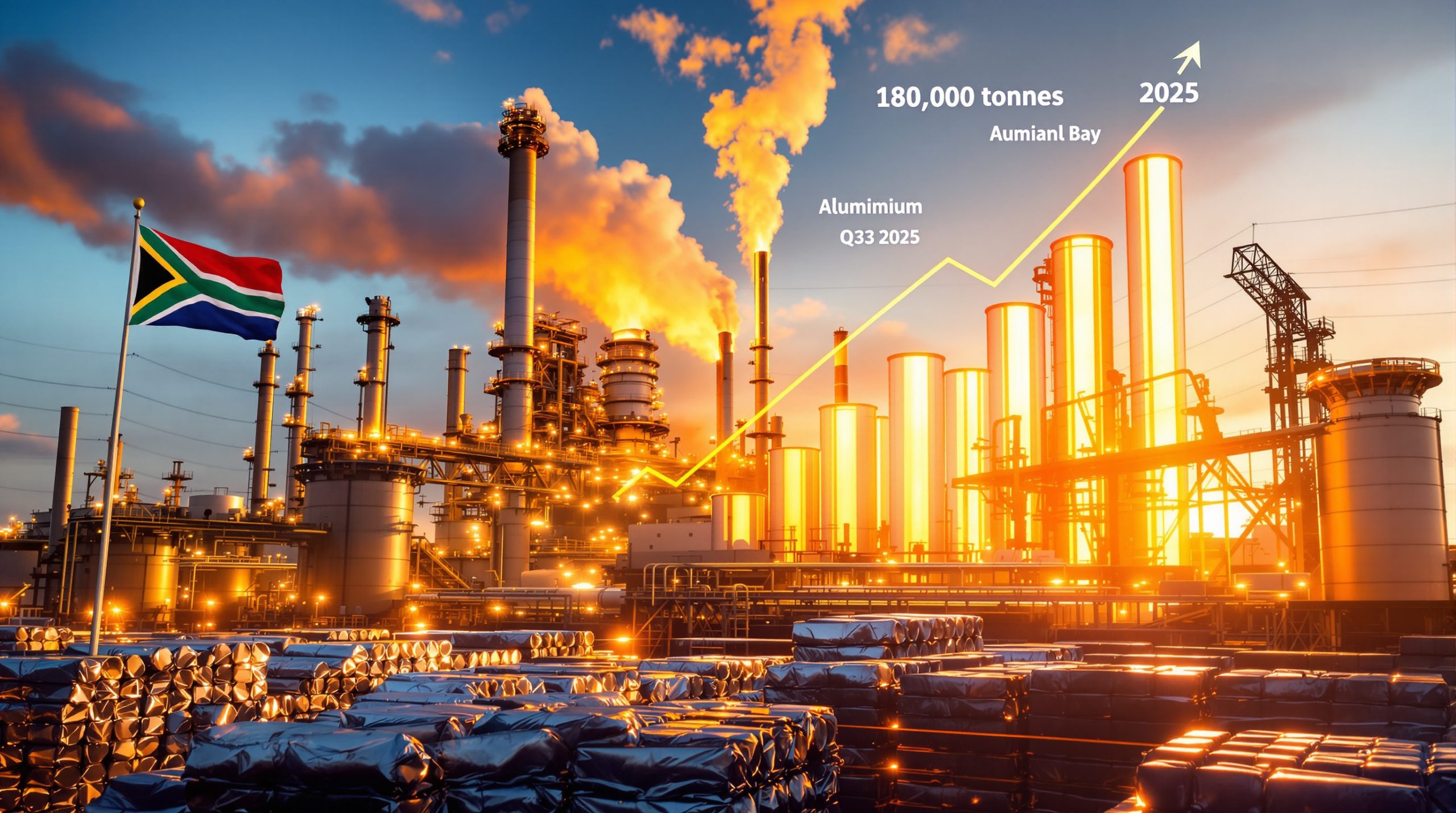Understanding the Strategic Australia-US Critical Minerals Partnership
The recent Albo-Trump critical minerals deal between Australia and the United States represents a fundamental shift in global critical minerals supply chain strategy. This comprehensive partnership addresses long-standing concerns about mineral security and establishes new frameworks for cooperation between allied nations.
The initiative focuses on developing secure supply chains for materials essential to defense technologies, renewable energy systems, and advanced manufacturing. Furthermore, the partnership aims to reduce dependence on dominant global suppliers while strengthening strategic mineral production capabilities across both nations.
Financial Architecture and Investment Framework
The investment structure encompasses multiple funding mechanisms designed to accelerate critical mineral development projects. Government commitments from both nations target specific minerals where supply chain vulnerabilities pose the greatest risk to national security and economic stability.
Key investment categories include mining project development, processing facility construction, and research initiatives for advanced extraction technologies. Additionally, the framework prioritises projects that can demonstrate significant production capacity within accelerated development timelines.
Processing capabilities receive particular attention, as this segment has historically concentrated in limited geographic regions. The partnership specifically targets separation and refining technologies that can compete with existing global capacity while maintaining cost competitiveness.
Australian Mining Companies Positioned for Strategic Growth
The agreement creates distinct market opportunities for companies with exposure to designated critical minerals. However, market positioning varies significantly based on production status, mineral categories, and development timelines.
Established Producers Gaining Momentum
Alcoa Corporation represents a prime beneficiary through its existing alumina refining operations in Western Australia. The company's established infrastructure positions it to expand gallium recovery operations, addressing a critical gap in semiconductor supply chains.
Gallium applications extend beyond traditional uses into advanced defence technologies including radar systems and electronic warfare capabilities. Current global production concentrates heavily in China, creating strategic vulnerabilities that the partnership aims to address.
Lynas Rare Earths operates as Australia's only significant rare earth producer, with mining operations at Mt Weld in Western Australia and processing facilities in Malaysia. Despite market volatility following the announcement, the company maintains critical strategic importance in global rare earth supply chains.
Development-Stage Companies Attracting Investment
Arafura Resources advances the Nolans Project in Northern Territory, targeting neodymium and praseodymium production essential for permanent magnet applications. The project addresses specific rare earth elements with high strategic value for defence and renewable energy sectors.
The Northern Territory location provides political stability and favourable mining jurisdiction advantages compared to many global rare earth projects. Processing technology development remains a key focus for achieving commercial viability.
Latrobe Magnesium pursues a unique market position as a potential primary magnesium producer in Australia. The company's Victoria-based project addresses critical supply chain gaps, as the United States currently maintains no domestic primary magnesium production capacity.
Magnesium applications in aerospace and defence manufacturing create strategic importance beyond traditional industrial uses. Consequently, lightweight structural components increasingly require magnesium alloys for advanced vehicle and aircraft systems.
Global Supply Chain Reconfiguration Implications
Addressing Chinese Market Dominance
China currently controls approximately 60% of global rare earth mining and 85-90% of rare earth processing capacity as of recent industry assessments. This concentration creates significant supply chain vulnerabilities for Western defence and technology industries.
Historical precedents demonstrate the risks of concentrated supply chains. In 2010, temporary Chinese export restrictions caused global rare earth price increases of over 300% within months, highlighting supply chain fragilities.
The partnership specifically targets processing capabilities, as separation and refining represent the most technically challenging and capital-intensive segments of rare earth production. Building alternative processing capacity requires substantial investment and technical expertise.
Defence Technology Security Considerations
Critical minerals covered by the agreement serve essential defence applications. Moreover, the critical minerals energy security implications extend beyond traditional mining considerations:
• Gallium: Semiconductor applications for radar and satellite systems
• Rare Earth Elements: Precision guidance systems and electronic warfare
• Lithium: Energy storage for defence platforms
• Magnesium: Lightweight aerospace structural components
• Cobalt: Advanced battery technologies and superalloys
These materials cannot be easily substituted in high-performance applications, creating strategic dependencies that national security frameworks must address through diversified supply chains.
Investment Strategy Implications for Mining Sector Allocation
Risk-Adjusted Returns in Strategic Minerals
The partnership introduces government backing mechanisms that fundamentally alter risk profiles for critical mineral investments. Direct equity participation and loan guarantees reduce traditional mining project risks while maintaining commodity price exposure.
Historical analysis of government-supported mining projects demonstrates improved success rates compared to purely commercial developments. However, technical and operational risks remain significant factors in project evaluation.
Sector Rotation Dynamics
Investment flows increasingly favour strategic minerals over traditional bulk commodities. This rotation reflects growing institutional recognition of supply chain security as an investment theme beyond pure commodity cycles.
Market valuation methodologies for critical mineral companies incorporate strategic value premiums that traditional mining valuations may not capture. Furthermore, effective investment strategy components now require additional valuation complexity requiring specialised analysis frameworks.
Priority Minerals Under the Strategic Framework
Tier One Critical Materials
The agreement prioritises materials with immediate defence applications and severe supply chain vulnerabilities. Primary focus areas include rare earth elements for permanent magnet applications and gallium for semiconductor technologies.
Rare Earth Elements encompass 17 chemically similar metals essential for modern technology applications. Processing complexity creates significant barriers to entry, as separation requires sophisticated chemical processes and substantial capital investment.
Light rare earth elements including neodymium and praseodymium command particular attention for permanent magnet manufacturing. These materials enable high-efficiency motors for electric vehicles and wind turbine generators.
Heavy rare earth elements like dysprosium and terbium serve specialised applications in advanced technologies. Production concentrates even more heavily than light rare earths, with China controlling over 95% of heavy rare earth supply.
Lithium demand projections indicate potential 1,500% increases by 2030 compared to 2020 levels, driven primarily by electric vehicle battery requirements. Australia currently produces approximately 47% of global lithium, providing strategic advantages for partnership development.
Secondary Strategic Materials
Magnesium represents a critical gap in North American production capabilities. The United States maintains no primary magnesium production, relying entirely on imports and recycling for approximately 65,000 metric tons of annual consumption.
China produces approximately 87% of global primary magnesium, creating strategic vulnerabilities similar to rare earth markets. Magnesium applications in aerospace and automotive lightweighting drive increasing demand from defence sectors.
Cobalt supply chains face geographic concentration risks, with the Democratic Republic of Congo producing approximately 74% of global mine production. Chinese companies control roughly 80% of DRC cobalt production through ownership or purchase agreements, particularly following the DRC cobalt export ban discussions.
Market Competition and Processing Development
Breaking Processing Monopolies
Establishing processing capabilities outside Chinese control requires substantial capital investment and technical expertise transfer. Rare earth separation involves complex hydrometallurgical processes with significant environmental management requirements.
Processing facility development timelines typically extend 3-5 years for proven technologies, with additional time required for environmental approvals and workforce development. Technical risks include achieving separation efficiency and product purity standards required for end-use applications.
MP Materials demonstrates potential pathways for Western rare earth processing development. The company's California operations initially shipped concentrate to China before developing on-site processing capabilities, illustrating the challenges of establishing integrated supply chains.
Price Stability Through Diversification
Diversified supply chains should reduce the extreme price volatility that has historically characterised critical mineral markets. Rare earth prices experienced increases exceeding 100% between 2020 and 2022 before declining significantly, reflecting supply-demand imbalances and speculative trading.
Long-term supply agreements between governments and producers may provide greater price stability for downstream manufacturers. However, commodity price cycles will likely continue influencing project economics and investment returns.
Regulatory and Development Acceleration
Streamlined Approval Processes
Strategic mineral designation may expedite environmental approvals and permitting processes that traditionally extend mining project development timelines. Australian mining projects typically require 18-36 months for major environmental approvals under current regulatory frameworks.
Fast-track mechanisms could reduce development timelines while maintaining environmental protection standards. However, community consultation and impact assessment requirements will likely remain unchanged for most projects.
Technical Barriers and Solutions
Establishing competitive processing capabilities requires addressing multiple technical challenges including metallurgical complexity, environmental management, and product quality standards. Rare earth processing generates significant waste streams requiring sophisticated treatment technologies.
Technology transfer partnerships with existing processors may accelerate capability development while reducing technical risks. However, intellectual property constraints and competitive considerations may limit knowledge sharing opportunities.
Investment Portfolio Construction Considerations
Sector Allocation Strategy
Critical mineral exposure provides portfolio diversification benefits through reduced correlation with traditional commodity cycles. Strategic mineral prices respond to geopolitical factors and supply chain disruptions rather than purely economic demand cycles.
Government backing mechanisms reduce political and financing risks but do not eliminate technical, operational, or market risks inherent in mining investments. Due diligence requirements remain essential for evaluating management capabilities and technical feasibility.
The Australia minerals reserve initiatives further support long-term strategic planning for investors considering critical minerals exposure.
Risk Management Framework
Junior mining companies exhibit high volatility with beta coefficients often exceeding 1.5 relative to broader market indices. Critical mineral companies may demonstrate different risk characteristics due to strategic importance and government support mechanisms.
Portfolio construction should consider development stage, funding requirements, technical risks, and management track records. Diversification across multiple critical minerals and development stages can help manage sector-specific risks.
Future Outlook and Implementation Challenges
The Albo-Trump critical minerals deal faces several implementation challenges that could affect its long-term success. Supply chain development requires sustained political commitment across multiple election cycles, which creates uncertainty for long-term investment planning.
Technical expertise development represents another significant challenge. Australia possesses extensive mining experience but limited rare earth processing capabilities, requiring substantial workforce training and technology transfer programmes.
According to recent market analysis, the agreement has already generated significant investor interest, with Australian mining stocks experiencing notable price movements following the announcement.
Investment Disclaimer: Critical mineral investments involve substantial risks including technical, operational, regulatory, and market risks. Government support does not guarantee project success or positive investment returns. Investors should conduct thorough due diligence and consider their risk tolerance before making investment decisions.
The Albo-Trump critical minerals deal represents a significant strategic initiative that could reshape global supply chains and create new investment opportunities in the Australian mining sector. However, successful implementation will require sustained political commitment, substantial capital investment, and successful navigation of complex technical and regulatory challenges.
Looking to Capitalise on Critical Minerals Investment Opportunities?
Discovery Alert's proprietary Discovery IQ model delivers instant alerts on significant ASX mineral discoveries, including critical minerals that could benefit from strategic partnerships like the Albo-Trump deal. Explore Discovery Alert's discoveries page to understand how major mineral discoveries have generated substantial historical returns, then begin your 30-day free trial to position yourself ahead of the market in this rapidly evolving sector.




